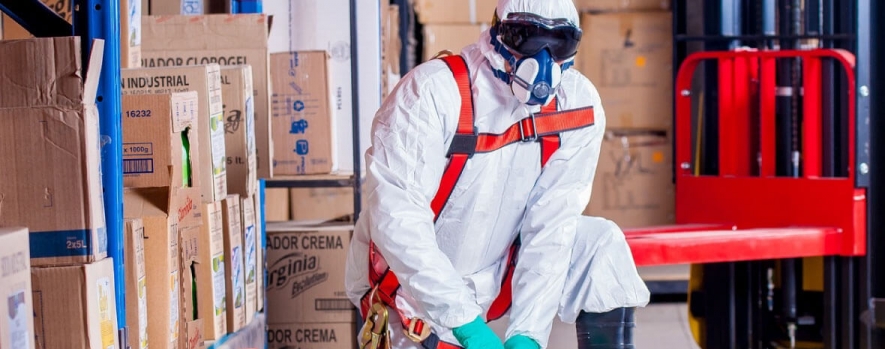
If you’re among the many workers who rely upon personal protective equipment (PPE) and disposable protective clothing to keep you safe, then the thought of a compromised PPE garment should give you pause. The good news is that there are things you can do to avoid experiencing a contaminated PPE garment as well as procedures to follow if you experience garment failure while using it.
Identifying a Compromised PPE Garment Before Using it
Although it takes a little time and effort, you should always build in a careful inspection of your protective garment as part of your routine before you put it on. Even if it is fresh out of the box,, you still want to have the peace of mind knowing that you’ve carefully inspected the garment to make sure it is ready for use and not already compromised. For non-disposable protective clothing, it’s important to keep in mind that normal usage over time will cause wear and tear on the garment, and more so if it has been exposed to contaminants or critical stress multiple times.
Begin with familiarizing yourself with any information supplied by the garment’s manufacturer, which should include an “end of life” estimation either as a specific date or according to how long the garment has been used. Obviously, if there are visible signs of a compromised PPE garment, you wouldn’t want to use it. Signs of heavy damage such as cracks, tears, holes, fraying edges, broken zippers, and so on are clear signs that a garment should be set aside and replaced. Here are some further guidelines for specific articles of clothing:
- Gloves: Signs of wear and tear on a glove are important to identify as these can lessen the glove’s protection and ability to provide its gripping function. Put the gloves on and go through the motions of using tools and equipment similar to what you’ll be using to make sure they are operational enough for use.
- Eye Protection: Safety glasses and other eyewear should be inspected for scratches or other damage that could impair your vision during critical operations and tasks. If they fit more loosely than they should, discard them. You need protective eyewear to stay put when in use!
- Helmets/Headgear: Look at headgear for cracks, holes and other signs of damage and once test for a snug fit.
- Garments: Jackets, pants and full body suits should first receive a thorough visual inspection for tears, fraying edges, or heavily worn areas that look or feel “thin.” The garment should then be put on to make sure it still fits the right way, not being too tight or inhibiting the movements you need to make during your work activities.
If your thorough inspection of the protective clothing you’re expected to use reveals any of these signs of being compromised, select another and let a supervisor or manager know it needs to be discarded and replaced.
Employer Responsibilities Regarding a Compromised PPE Garment
Employers need to be very conscientious in the selection of PPE for their workers. Depending on the situation, the employer could face costly litigation and reputational damage if the company was negligent in its selection of PPE that wasn’t of the highest quality possible or if it failed to train workers in its proper use. Most companies do a good job of selecting PPE that matches the intended application and is both compliant with all applicable regulations and also independently tested by a third party to make sure it is robust in meeting safety standards.
Dealing with a Compromised PPE Garment While Using it
With the careful inspection tips laid out earlier, workers should be able to easily avoid inadvertently using an already compromised PPE garment. But that’s only half the equation when it comes to protective clothing. What happens if a PPE garment becomes compromised while it is being worn?
The workers who are using PPE garments should have received extensive training in their specific work environment that included not only the proper use of PPE but also how to respond to accidents and emergencies. One of those scenarios could include the failure of a PPE garment. If you’re wearing a protective suit to keep out various contaminants such as chemicals or blood-borne pathogens, , an accident could occur that results in a compromised PPE garment, such as the suit getting caught on something sharp and tearing a hole in it.
Immediately tell your co-workers what’s happening and then safely exit the work environment with the hazard and begin going through the normal protective suit removal procedures you were taught. Once safely out of the garment, you should then immediately begin any other safety protocols and procedures you were taught related to exposure to the hazardous substances that were in the work environment.
A compromised PPE garment is a grave concern both for the workers using the protective clothing as well as the companies concerned about the safety of their employees. While accidents can happen, the risk of illness, injury or death is greatly minimized when the people involved stay calm and rely on the training they received for these kinds of incidents.
Companies that want to enhance employee safety and comfort without compromising productivity will find a wide range of solutions with International Enviroguard’s extensive assortment of disposable protective clothing and other products for use in a huge variety of industries. We provide PPE solutions for dust and particles, sparks or flame, chemical splashes, remediation, black water, blood & blood-borne pathogens, controlled environments, and more. Contact us with any questions you may have – the safety, comfort, and productivity of your workers is our business!